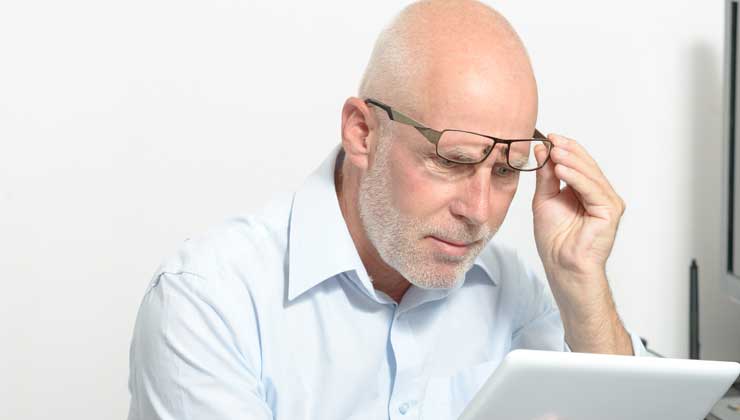Over 60s eye health
12 de April de 2022
How does age affect eye health?
Age is a major risk factor for the onset of certain, very serious eye diseases.
Some of them, such as Macular degeneration or Glaucoma, are progressive and irreversible and are often symptomless until they have reached advanced stages of development, by which time loss of vision can be significant. Other age-related visual problems include cataracts, presbyopia or tired eyes -which can appear after the age of 40-, as well as floaters, dry eye, or corneal opacity.
If treated in time, age-related eye disorders can be controlled and will not have a determining effect on your everyday activity.

Eye disorders should be treated in time
How often should you visit the ophthalmologist?
After the age of 60 or 65, preventive measures for early diagnosis of these diseases must be increased. Provided there are no added risk factors, it is important to undergo a full eye check-up at least once a year.
How to prevent eye problems later on in life?
- Undergo full eye check-ups at least once a year
- Eat a healthy, balanced diet rich in antioxidants and Omega 3
- Do not smoke or stop smoking
- Exercise in line with your individual characteristics and possibilities
- Protect your eyes from the sun and from external agents (air, dust, sand, etc.)
- Monitor your blood pressure
- Monitor your cholesterol levels
- Monitor your blood glucose levels (especially diabetic patients)
- Check your own eyesight: keep up to date with check-ups, treatments and recommendations by your ophthalmologist
- Do not resign yourself to vision loss due to age…
Vision loss later on in life is particularly restrictive, given that the capacity to adapt in this situation is lower than in earlier ages and the eyesight problem can be added to other age-related physical and mental conditioning factors. Poor vision in old age can cause falls, fear of going outside, and lack of contact with the environment, resulting in feelings of isolation and the onset of depression.

Eye disorders over the 60s can be prevented
Main age-related eye diseases
Other frequent eye problems in old age
IMO Institute of Ocular Microsurgery
Josep María Lladó, 3
08035 Barcelona
Phone: (+34) 934 000 700
E-mail: international@imo.es
See map on Google Maps
By car
GPS navigator coordinates:
41º 24’ 38” N – 02º 07’ 29” E
Exit 7 of the Ronda de Dalt (mountain side). The clinic has a car park with more than 200 parking spaces.
By bus
Autobus H2: Rotonda de Bellesguard, parada 1540
Autobus 196: Josep Maria Lladó-Bellesguard, parada 3191
Autobuses H2, 123, 196: Ronda de Dalt – Bellesguard, parada 0071
How to arrive at IMO from:
IMO Madrid
C/ Valle de Pinares Llanos, 3
28035 Madrid
Phone: (+34) 910 783 783
See map in Google Maps
Public transport
Metro Lacoma (líne 7)
Autobuses:
- Lines 49 & 64, stop “Senda del Infante”
- Line N21, stop “Metro Lacoma”
Timetables
Patient care:
Monday to Friday, 8 a.m. to 9 p.m.
IMO Andorra
Av. de les Nacions Unides, 17
AD700 Escaldes-Engordany, Andorra
Phone: (+376) 688 55 44
See map in Google Maps
IMO Manresa
C/ Carrasco i Formiguera, 33 (Baixos)
08242 – Manresa
Tel: (+34) 938 749 160
See map in Google Maps
Public transport
FGC. Line R5 & R50 direction Manresa. Station/Stop: Baixador de Manresa
Timetables
Monday to Friday, 09:00 A.M – 07:00 PM




